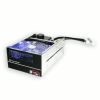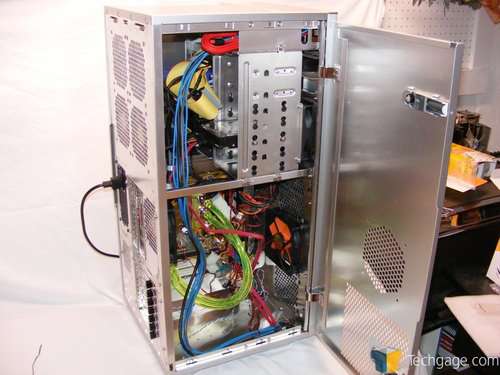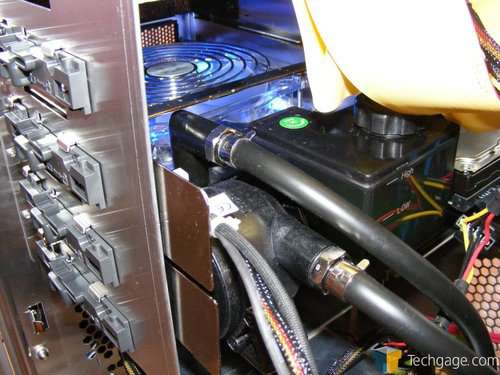- Qualcomm Launches Snapdragon 4 Gen 2 Mobile Platform
- AMD Launches Ryzen PRO 7000 Series Mobile & Desktop Platform
- Intel Launches Sleek Single-Slot Arc Pro A60 Workstation Graphics Card
- NVIDIA Announces Latest Ada Lovelace Additions: GeForce RTX 4060 Ti & RTX 4060
- Maxon Redshift With AMD Radeon GPU Rendering Support Now Available
Thermaltake BigWater 760i

If you thought about liquid-cooling your PC, but were put off by the complexity of a typical installation, Thermaltake’s BigWater 760i may be the solution for you. The drive-bay mounting system is a novel solution, but can it provide enough of an advantage over air-cooling to make it worthwhile?
Page 5 – Thermal Performance and Noise
All heatsink testing at Techgage is performed with three considerations in mind: repeatability, accuracy, and comparison. In order to achieve these three aims, it’s important to use a standardized testing platform for all measurements which are to be compared.
In this case, the test platform is based around an AMD Athlon X2 “EE” model, which operates inside a 65-watt thermal envelope, similar to most Intel Core 2 Duo CPUs. What’s most important, however, is that the test platform be consistent in its operation, so that the thermal margins provided by each CPU cooler can be directly compared – since it’s the proportional change that we really care about.
- The Test Rig
- CPU: AMD Athlon 64 X2 4200+ EE (65W)
- Motherboard: ASUS M2NPV-VM (nForce 430, GeForce 6150)
- Memory: 1GB (2x512MB) A-Data Vitesta DDR2-1000 @ DDR2-800
- GPU: eVGA GeForce 7600GT KO 256MB
- Hard Drive: Western Digital 160GB, 7200RPM, 8MB Cache, SATA2
- Power Supply: OCZ StealthXStream 600W
- Case: Thermaltake Mozart TX*
*Used for this review due to extenuating circumstances
Rationale
The test system was originally designed to simulate the airflow of a typical enthusiast PC, minus any extraneous heat loads provided by a separate GPU, massive hard drive arrays, et cetera. However, in testing with a separate discrete GPU installed, it was found that significantly higher CPU temperatures under load were attainable with our particular type of stress test, indicating that the IGP was actually limiting the heat generation potential of the CPU.
For this reason, effective immediately, the test system will be revised to contain a reference video card as well. New measurements made using this test platform are not comparable to previous measurements, so new measurements have been made of all CPU coolers used in comparison for this article.
In addition, it seems that as CPU coolers continue to push the cooling envelope, and compact all-in-one water cooling solutions gain popularity, necessitating a greater heat load, the current test system may be pushed into obsolescence in the near future because of its relatively small 65-watt heat load when compared to the nearly 130-watt heat load of modern quad-core CPUs.
For this review, the Thermaltake Mozart TX case was substituted for the Cooler Master iTower 930, due to space issues in accommodating the Thermaltake BigWater 760i’s radiator unit.
Procedure
Before installing either the water block or the cooler, a ball bearing-sized drop of Arctic Silver was spread into a thin layer using the sharp edge of a razor blade. During testing, Cool N’ Quiet was disabled, as well as the board’s “Q-Fan” smart fan control. The system was first allowed to reach a stable idle temperature for about 30 minutes before testing was performed.
Then 3DMark 2006 was run with its default settings to load both cores, and the peak observed temperatures were recorded after about 30 minutes of continuous load (looping tests). Finally, the system was allowed to return again to a stable idle temperature, and the peak observed idle temperature was recorded.

I’m using APACK’s ZEROTherm NV120 “Nirvana” cooler as a reference in this test, because it represents just about the top of the heap in enthusiast air-cooling, outstripping the cooling ability of the Zalman CNPS9700 by a small margin. The Thermaltake BigWater 760i’s simple, integrated design is meant to compete with high-end air-cooling solutions, so this comparison makes sense.
While the Thermaltake BigWater 760i certainly holds its own in the testing, it failed to eke out a lead against the high-end air cooling solution under load. Water cooling systems can handle transient loads well, thanks to their higher thermal mass, so to eliminate this potential for error, the CPU was loaded continuously for about 30 minutes before making temperature readings.
That the BigWater 760i system didn’t offer a performance advantage over the high-end air cooler isn’t a nail in the BigWater 760i’s coffin, however. These temperatures are excellent for any thermal solution, with the idle temperature being very near room temperature. The BigWater 760i definitely gets the job done.
Noise
The BigWater 760i has two major noise- and vibration-producing components. The pump itself is a significant source of vibration, though it does not generate much in the way of acoustic noise. If it’s not rigidly mounted, however, it can generate a low hum that resonates throughout the metal case.
The 120mm fan mounted to the radiator is still plainly audible even at its lowest speed, with audible turbulence and motor noise, though at high speed, blade noise dominates the sonic signature. In addition, the radiator unit emanates the sound of flowing coolant which, while soothing, isn’t silence. I can’t recommend this product for a ‘silent’ PC, though it may find a home in a ‘low noise’ system.
|
|
Support our efforts! With ad revenue at an all-time low for written websites, we're relying more than ever on reader support to help us continue putting so much effort into this type of content. You can support us by becoming a Patron, or by using our Amazon shopping affiliate links listed through our articles. Thanks for your support!






